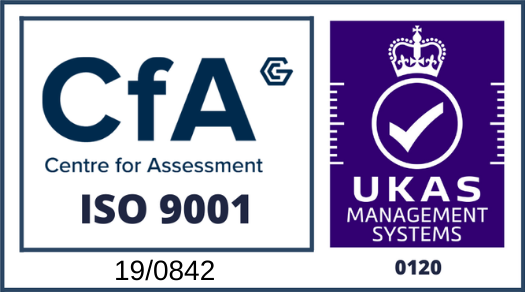How to Maximise the Performance of Your Existing Systems
A guide to navigating legacy systems.
Introduction
Business, markets and technology constantly evolve. Yet many business critical software systems are connected to purpose-built software infrastructure which can be challenging to adapt to change.
Existing technology infrastructures are often inflexible, need ongoing management and resource, and multiple customisations and integrations to ensure disparate systems communicate with each other.
Inefficient software platforms inevitably impact on performance and efficiency across departments, business functions and potentially customer experience.
However, legacy issues are not just experienced as pain in the business. An inability to innovate, change business models, improve customer experience, respond to market forces, drive productivity and efficiency and ultimately gain competitive advantage arise as lost opportunities that can have a greater impact on business performance.
The challenge is how to upgrade, evolve or replace existing systems with minimal business disruption to enable your business to meet increasingly demanding customer needs and stay ahead of the competition.
Decision making is not easy. Business leaders need to consider how to keep the business delivering today, operating business as usual to meet current organisational needs, while planning for future needs with upgrades, integrations, or deletions.
There are an array of options to consider which vary depending upon the current performance of systems, the type of software products preferred (off-the-shelf, bespoke, cloud hosted) and the scale of the business both today and tomorrow.
This content has been created to help CEOs, CTOs and CIOs navigate this landscape and take timely decisions to maximise the performance of existing systems, using a combination of industry research and direct experience implementing a variety of business critical software projects, across multiple industry sectors.
The Challenges & Risks Associated with Legacy Software Projects
The challenge of legacy
Most businesses were having difficulties with inefficient systems years or even decades ago – and most still are today.
As new technologies come to market and businesses and their customers evolve, outdated, inflexible software platforms can significantly impact performance across departments and functions.
As painful as these systems can be, it is often daunting to replace them with a new software product or go through the complexity of legacy system integration.
For many business leaders, making decisions about changing existing or legacy systems is not straightforward. These systems often support business critical applications.
There will be questions pertaining to downtime minimisation; how to execute improvements without losing data; cost; risk of failure or system breakdown; appropriate resourcing; the scale and complexity of an upgrade project.
The status quo often prevails, until a catalyst like an ambitious new IT director getting approval on a sizeable budget, or a CEO seeking to transform their business, gets the process started.
Regardless of the challenges when it comes to keeping a business’s processes working efficiently or indeed maximising the performance of your business, it is essential to address legacy systems, particularly when they reach end of life.
When thinking about existing systems it is not just a question of age and redundancy. Any system which no longer meets the needs of a business and it's customers, for which the cost of maintenance is no longer cost-effective or which utilises old code requiring skilled tech support to update, can be considered legacy.
Understanding the risks
If you have decided that it is time to address the challenges of your existing systems then it is important to understand the risks and importantly how to mitigate them.
Businesses who engage in IT software projects do so in the face of some scary statistics relating to project failures, budget overruns and software misbehaving after release.
Research undertaken by McKinsey in conjunction with the BT Centre for Major Programme Management at the University of Oxford discovered that on average, large IT projects run 45% over budget and 7% over time, while delivering 56% less value than predicted.
And 17 % of large scale projects, categorised as having an initial budget exceeding £10 million, failed so badly that they “threatened the very existence of the company”.
Such projects are labelled within the industry as “Black Swan” projects, defined as projects with budget overruns of at least 200%. (Black Swan is a term originally coined by Nassim Nicholas Taleb to define low probability events with a large impact, which, with hindsight, are accepted as being rational and foresee-able).
However, it’s not all doom and gloom. In the past year, organisations have experienced more success implementing strategic initiatives, with the top performing organisations approaching systems development.
Organisations that use proven project management practices waste 28 times less money than those that do not have practices in place.
(PM360 Consulting, Project Management Statistics, 2023)

Levi Strauss migrated to a $5 million SAP solution. During the switch over the business was unable to meet orders and was forced to close 3 distribution centres for a week, resulting in the business putting a charge against earnings of $192.5 million as a direct result of the failed implementation.
(Harvard Business Review - Why your IT project may be riskier than you think)
BSkyB’s appointment of EDS to implement a CRM system with a cost of £48 million sued for damages of £709 million. This was well in excess of EDS’ £30 million limitation of liability, which was removed due to BSkyB’s claim of misrepresentation by EDS being upheld.
(Pinsent Masons - BskyB vs EDS)
Four Management Strategies to Increase the Success of Software Projects
#1 Executive Sponsorship
Executive sponsors continue to be the top driver of whether projects meet their original goals and business intent. (PMI’s Pulse of the Profession Survey, 2018)
77% of high-performing organisations have actively-engaged project sponsors, while only 44% of low-performing organisations do.
(PMI’s Pulse of the Profession Survey, 2017.)
An effective executive sponsor understands how the project aligns to the overall business strategy and is able to keep all stakeholders focused on this vision. He or she has an understanding of the project detail and can remove roadblocks, support the project team in making quick decisions and influence the executive leadership team.
When it comes to timely and effective delivery of software projects, a key role is in upwardly managing projects. Ensuring that the business benefits are clearly understood at board level and that appropriate resources (in people and budget) are allocated to meet the intended outcomes.
The executive sponsor plays a critical role in gaining cross-company buy-in in the implementation and roll-out of new software.
Developing effective executive sponsorship may require a cultural shift, where this role is seen as a critical project resource and recognised as added value. For many organisations there is a need to clearly define the role of the sponsor, align expectations with the project team and be realistic about time and resource commitments from the sponsor.
Importantly the role of sponsor is to enable the project team to deliver the project outcomes rather than steward projects to completion.
#2 Empowered Project Owners
Project failure is due to lack of ownership or clear objectives rather than lack of project talent. (Harvey Nash/KPMG CIO Survey, 2018)
The demand for experienced project managers is growing faster than the demand in any other occupation, with approximately 88 million workers expected to be staffed in roles related to project management by the year 2027.
(Project Management.com, 2023)
Ownership is not just about tasks and activities being completed accurately and on time. It's about accountability for outcomes pertaining to the business benefits of projects.
The skills that IT project managers need are evolving. From time, scope and scheduling skills to becoming leaders and owners in their organisations, asking the right questions, responding to change, delivering rapid results and focusing on the business benefits of the projects they manage. Projects need to be led by highly disciplined and skilled project owners.
As such, the project owner needs to be empowered to make decisions such as prioritising project needs (scope, budget and time) and prioritising and sequencing the backlog according to business value or ROI.
Fully owning the backlog means that a team can avoid producing outputs that do not add value to the desired project outcome. The team can instead work on valuable changes and avoid wasting time debating whether an option is valuable or not based on limited information.
It may also be important to encourage code ownership by giving developers primary ownership of portions of the code base and not allowing other developers to change that code without approval from the primary owner. In doing so, you can not only increase productivity of individual developers, but also highlight weaknesses within teams.
#3 Transparent Communication
Organisations that are minimally-effective communicators report significantly fewer projects that meet original goals.
Organisations that prioritise power skills – such as communication, collaborative leadership, problem-solving, and strategic thinking – experience significantly better project outcomes. Specifically, 72% of their projects meet business goals, only 28% experience scope creep, and they incur less budget loss (17%) when a project fails.
(PMI’s Pulse of the Profession Survey, 2023)
Despite the clear benefits of effective communication, many organisations do not place adequate importance on it within project delivery. Few project teams set out to communicate poorly, and many challenges can be easily resolved with the right approach to communication.
Create a culture of collaboration within the project, founded on transparency, trust and ongoing dialogue. Sharing relevant information in real-time ensures decisions can be made more quickly, enabling the project to progress at pace. When working with suppliers, ensure the same values of open and transparent communication are upheld.
Complex projects can involve distributed teams with a high degree of stakeholder interdependency. So, avoid using email, spreadsheets or multiple channels for maintaining and sharing information. Use project management software to store and regulate key information such as timelines, budget, and documentation, and use a collaboration tool for ongoing project communication, status updates, dashboards with real time performance indicators, best-practices and lessons learned.
It is important to balance formal and informal communication. A clear communication strategy adapted to different stakeholder needs, weekly or bi-weekly check-ins and defined reporting and change management practices play a role in enabling communication. However, especially in agile delivery, information sharing and communication needs to happen in real-time, rather than being defined by formal communication channels.
#4 Tackle Risks Early
All projects are inherently risky, because all change involves risk.
Poor planning accounts for 39% of project failures, highlighting the essential importance of effective planning throughout the project lifecycle. Effective planning involves more than just setting timelines; it requires aligning project objectives with business goals to reduce the risk of failure.
(Electro IQ, Project Management Statistics, 2025)
Executive teams expect project teams to plan for all the variables in a complex project in advance in order to minimise risk. However, while some risks can be planned for, many risks cannot be anticipated ahead of development.
According to Harvard Business Review there are 3 types of risk in software projects:
1. "Execution risk" - the risk that planned activities won’t happen correctly.
2. "Integration risk" - the risk that all the different work streams won’t come together coherently at the end.
3. "White-space risk" - the risk that key activities needed for a projects’ success aren’t identified in advance, leaving gaps in the project plan.
Execution and integration risks can usually be identified, but are often not addressed quickly. With these risks, the earlier they are resolved the more likely the project will succeed.
The bigger challenge is in managing white-space risk. After all, how do you prepare for an undefined task, that you are not yet aware of?
The solution lies in changing the way projects are planned and delivered. An agile approach to development involves short development iterations, rapid prototyping and a feedback loop informing the next iteration. Taking a more modular approach to projects helps to uncover both white space risks and integration risks in real time. The key to managing any risk is to get something working as quickly as possible, test and refine.
Four Approaches to Maximise the Performance of your Existing Systems
Overview
When you know that your existing systems are no longer fully fit for purpose, the business will face a number of decisions in terms of modernising, extending, customising, upgrading or replacing systems.
There are times where it is faster and more cost effective to completely replace a system rather than waiting longer to decide how to integrate the old with the new. In other situations, it is possible and preferable to integrate new tools into existing technologies.
Here we outline four approaches, depending on the stage and status of your existing framework. These four methods will help maximise the performance of existing software infrastructure.
Importantly, these approaches aren’t exhaustive or mutually exclusive, and businesses will probably take a ‘mix and match’ approach using some or all of the methods.
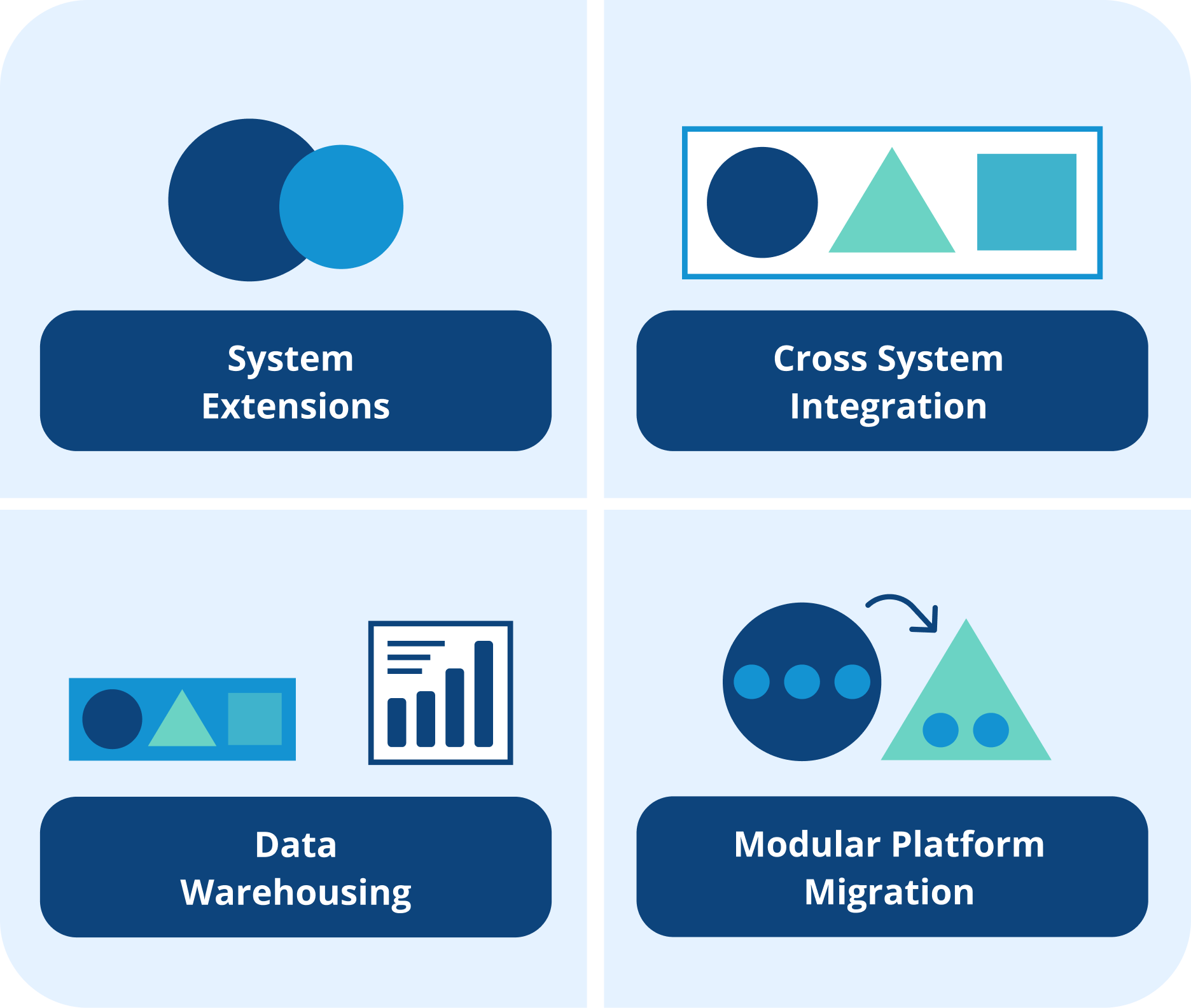
1. System Extensions
For isolated problems
If you have isolated problems, instead of ripping out and replacing existing legacy systems, build a product that exists alongside and integrates with your current systems.
System extensions can introduce automated workflows over existing systems that can ensure consistency across users, with the ability to capture information and provide detailed reporting.
This gives you the opportunity to develop a richer user interface with additional functionality without having to replace your existing software or databases. You can do this as an extension for bespoke systems as well as products when there is an API available.
There are multiple ways of extending both off-the-shelf and bespoke products:
- Bespoke tools: system extensions may come in the form of bespoke tools, depending upon the integration options available (i.e. programming interfaces, data import/export, etc.)
- Developed using inbuilt programming languages, where the legacy system is a product offering such as SAP or Salesforce, which offer ABAP and Apex respectively.
Business Scenario:
- Our sales teams are exporting pricing data from our mainframe systems and generating their own bespoke proposals.
- Senior management has no visibility of the value or structure of pending opportunities.
- Operations are complaining that proposals are deviating from the products and services we offer.
Advantages
✅Rich and customised user interfaces.
✅Additional functionality.
✅Functionality builds upon existing databases.
Disadvantages
❌ May produce multiple user interfaces.
2. Cross System Integration
For interface overloads and multiple access
When your business has an interface overload, it is likely that various departments and functions need to access multiple separate systems on a daily basis.
The most appropriate software infrastructure here is a cross-platform interface (or wrapper). Just as with system extensions, you keep the existing legacy system but improve the interface and functionality around it.
Wrapper interfaces can be developed to:
Make internal operations more efficient.
Increase the productivity of customer and supplier interactions (by automating processes).
Reduce risk (by auditing workflow activity).
It may also be possible to support real-time cross-platform transactions across the underlying existing systems where suitable programming interfaces exist.
From a security perspective, relationships between user roles across systems will need to be considered.
In addition, where internal systems are being opened up to customers or suppliers, planning around hosting and security will be required.
Business Scenario:
- Customers email spreadsheets of orders.
- If the customer is new, we create them in our CRM package to get a customer reference, then add the order to our production system, then add the order to our finance system.
- We have a separate user account for each system.
Advantages
✅Single point of entry.
✅No duplicate entry web and mobile user interfaces.
✅Aggregated workflows.
Disadvantages
❌ Authentication services required to support single sign on.
3. Data Warehousing
Successful but separate software systems
A common situation is that businesses have successful but separate software systems, so inefficiency comes from a lack of centralised data.
In these situations the organisation can end up being overwhelmed by data from multiple sources, or people may struggle to extract the required data for decision making.
Aggregating data across multiple systems can provide businesses with the ability to make informed decisions based on consolidated, real-time information captured from multiple disparate systems.
Data can also be stored and modelled over time to measure the impact of decisions.
The main benefit of this approach is that it enables your existing data to drive decision making and performance without reworking existing systems.
Business Scenario:
- Our engineers use a stand-alone application on their laptops.
- Our finance system is hosted on an internal server.
- Our HR system is in the cloud.
Advantages
✅No changes to processes and user interfaces.
✅Automated data mapping and transformation.
✅Aggregated reporting and decision making.
Disadvantages
❌ Authentication services required to support single sign on.
4. Modular Platform Migration
Legacy systems with multiple undocumented customisations
Undocumented tweaks made over time, which could still be critical to day-to-day business, is one of the biggest fear factors that stops legacy system upgrades going ahead.
The solution is to rebuild the existing system or application one piece at a time.
Modular platform migration means separating the existing software system into modular components, enabling you to review your business needs against the module during the rebuild within an iterative and incremental upgrade path. This helps to remove the complexity of the task.
Systems with complex business logic will require a significant amount of input from the business to remodel, refine and validate the processes and workflows required.
A major benefit of a modular approach is to ensure that dependencies on the business can be allocated per module.
This enables the business to develop, test and migrate business critical systems incrementally significantly reducing the risk of system failures and the resulting impact on business performance.
Business Scenario:
- We need to upgrade our current VB6/Access system. It doesn’t meet the current business needs and performance is terrible.
- However, the system has 10 years of undocumented tweaks and changes made my multiple developers that may or may not still be relevant to the business.
Advantages
✅Iterative and incremental upgrade path.
✅Use new technology to refine workflows and processes.
✅Staged data migration.
Disadvantages
❌ Difficult with tightly coupled legacy systems.
Case Reviews
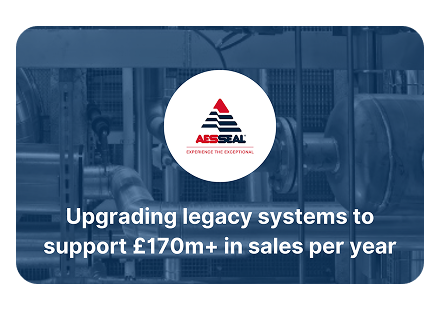
The Client
AESSEAL plc is the fourth largest mechanical seal manufacturer in the world, hitting a record £170 million turnover in 2017.
The global manufacturer employs 1,700 people across 104 countries. With a focus on customer service and quality, the organisation has grown year on year since they were established in 1979 and holds an incredible 13 Queen's awards.
4th largest mechanical seal manufacturer in the world
104 countries operated across globally
Background
When AESSEAL realised that their existing disparate legacy IT systems were becoming a barrier to sustaining planned growth, they looked to recruiting additional IT staff.
However, after realising the benefits of working with an agile, cross-industry experienced partner, they decided to engage in a collaborative development partnership with Audacia.
"The way that we work is that we are subject matter experts, we know our business, we know our customers, we can then have that conversation with the development team at Audacia. It is very much a collaborative 2 way process and the level of communication is just fantastic."
Stuart Welsh, Group IT Director, AESSEAL
Key Objectives
- A comprehensive overhaul of existing systems to maximise the efficiency and longevity of AESSEAL's business processes.
- Implementing an agile software development approach due to evolving requirements.
Key Business Challenges
▶ Reliant on a number of disparate legacy systems that had reached end of life, having little central management or control.
▶ Limited standardisation in processes across markets and sites.
▶ Lack of knowledge management between business functions prevented sales, engineering & management working to their full efficiency.
▶ Changes managed manually with multiple spreadsheet based processes.
▶ Lack of visibility in the management & design of non-standardised components across markets.
▶ Key data held "locally" preventing visibility & reporting of data cross sector, market and site.
▶ Challenge to share extensive knowledge and expertise efficiently across business.
▶ Backlog of challenging technical projects to deliver with limited capacity.
Our Approach
▶ Collaborative development project comprising of 3 AESSEAL developers and 3 Audacia developers
▶ Shared project leadership dependent on resource and phase - sufficient shared trust enabled a single team leadership
▶ Strong executive sponsorship enabled fast delivery. Shared ownership of vision and strategic direction and high level overview of business resourcing
▶ Face to face meetings every 2 weeks
▶ Solutions developed iteratively, aggregating modules at each stage of the process using a Modular Refactor approach
▶ Seamless combination of AESSEAL's domain expertise with Audacia's technology expertise
Key Project Challenge
Defining "Design Automation". Instead of giving Audacia their requirements, AESSEAL asked Audacia to find out the requirements based on what they wanted to achieve, walking through the process at a high level.
How We Resolved It
Utilised detailed complex logic around validating what was needed and possible. The team then dug down into how it would work undertaking extensive analysis, reporting back to AESSEAL with in depth analysis reports for user and stakeholder feedback on how automation would work flexibly. The same concepts were then used for different designs and products.
The Solution
A knowledge management suite comprising of three core modules:
Knowledge Database
A central analytical store of information relating to chemicals, chemical applications, rotating equipment, performance metrics etc. which provides teams with real-time access to environmental data when onsite, with the ability to download component technical drawings to their tablets for review.
- Sales and engineering teams now able to define sealing solutions onsite with the engagement of customers and have reduced the 35 hour quotation lead-time to under 30 minutes, a 72 fold reduction in time
- The application also holds competitor data to enable crossover searches to identify the appropriate alternative solutions provided by AESSEAL through a customisable search with any level of information
Site Survey
An application that records the structural layout of customer assets and installation, inspection and change management history of AESSEAL products
- It also calculates, aggregates and compares key metrics across installations and continuously suggests incremental performance improvements of seals
- Supported by bespoke mobile applications used by engineers onsite
- The programme provides sales teams with the ability to respond to customer requirements more competitively, enabling them to make statements about metric improvements supported by real-time evidence based on recorded maintenance statistics based on similar sealing solutions and site environments
Quotation Platform - "eVE"
An application that allows AESSEAL to rapidly quote for products that would otherwise require in-depth technical knowledge and ties together three pre-existing systems - also integrated with SAP, drawing service and a mobile app.
- The application allows rapid identification of applicable products safely, opening up the quoting process to less experienced Sales Engineers and increasing sales volumes while reducing costs
- Enables AESSEAL to create and manage more than 38,000 quotations each year with 260 users across 26 sites around the globe

Key Results
- Supporting over 170m+ sales per year
- Increasing quotation speed 72x; from 35 hrs to 29 mins
- Creating over 38,000 bespoke quotations per year
- Launched across 26 global sites; from US to Saudi Arabia
- Giving AESSEAL a competitive advantage on sites
- Increasing contract value from £10k to £800k in 3 years
- Successful delivery leading to further £1m investment
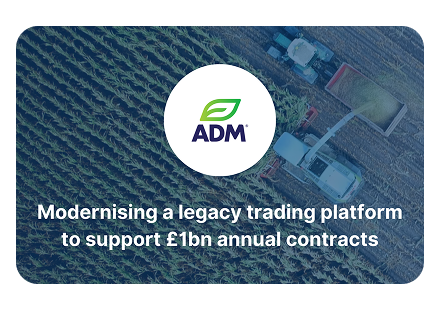
The Client
ADM Agriculture is a UK subsidiary of ADM, one of the world's largest agricultural processors and food ingredient providers, with more than 31,000 employees serving customers in 170+ countries.
As well as providing an integrated supply chain to ADMs UK assets in milling and oil seed crushing, ADM Agriculture supply a full range of non grain feed ingredients to the feed and fuel markets, alongside a comprehensive range of seed and fertilisers.
£1bn+ Annual commodity transactions traded
ONE of the world's largest agricultural companies
Background
ADM Agriculture has always been an early adopter of technology, however, when they started to realise that many of their employees' jobs had started to involve implementing workarounds on their current system to carry out their roles, they decided that their legacy system had reached end of life.
ADM Agriculture decided to engage with a business-critical technology partner to develop a modern commodities trading platform as part of a complex legacy upgrade, to support their business as it continues to grow.
With ADM Agriculture managing three core product areas; fertiliser, seed and grain, and each having 100’s of different product options with their own pricing rules, the business looked for a partner that was capable of interpreting complex business logic into an intuitive system.
Key Objective
To build a modern, bespoke trading platform to support ADM Agriculture as it continues to grow. Interpreting complex business logic into an intuitive system, using the latest technologies, that could scale in line with the future business growth plans.
Key Business Challenges
▶ Acquisition and merger with seed and fertiliser organisations brought multiple integration challenges.
▶ 3 core product areas; fertiliser, seed and grain. Each had 100’s of different product options with their own pricing rules.
▶ Customer base grew significantly with merger between 4 ADM companies, inheriting 50 years of
historical data.
▶ Customers had differing contractual terms with little data matching between systems.
▶ Challenge to integrate data, customers and product lines into a single system.
"With three major product areas to manage, each having hundreds of different product options and pricing rules, we needed a software partner to create a modern, adaptable trading platform. Audacia worked closely with our IT team to interpret our complex business-critical needs."
- Simon Lennon, Head of IT, ADM Agriculture
Our Approach
▶ Development team comprised of 2 ADM Agriculture developers & 6 dedicated members of the Audacia Team.
▶ Reviewed current processes, dissected what employees were actually doing and what the business was trying to achieve.
▶ 1/2 day face-to-face/virtual meeting every 2 weeks to review build, solve challenges and make decisions.
▶ Daily communication via Teams with ADM developers, with a continuous communication for rapid feedback loops.
▶ Scaled teams for specific time periods, deploying specialist developers for adjacent projects, including Xamarin development and customer portals.
Key Project Challenge
Multiple segregated job roles. Due to sensitive financial data, user access rights were restricted depending on role. This required complex interaction of access and editing rights and multiple security gateways.
How we Resolved it
Team undertook a 2 week deep dive to understand granular levels of detail. Defining multiple scenarios and developed numerous prototypes of potential solutions. The team tested prototypes with rapid feedback loops and iterations, developing a comprehensive solution through real-time feedback and deep understanding of the challenge.
The Solution
Streamlined and Automated Key Business Areas
Purchase and sales contracts for grain, fertiliser and seed products, including pricing structures on contracts (added as a fixed priced or a variable price dependent on market value at time of execution). Integrated market price alerts to notify traders on key price fluctuations. And integrated with two other core business systems, NetSuite and Red Tractor Assurance.
Vital Functionality to Support Business-Critical Invoicing Module
Streamlined the process of generating over 200 invoices per day. Covering collections and deliveries to and from farmers and consumers - including invoices for the farmer, consumer and haulier. With digitised footprints for claims made on delivery if product does not match the expected quality.
Provides Synchronised, Consistent and Accurate Data
Consistent data transfer across systems, updating factors such as invoice generation and supplier validity in real-time. Overall minimising costs and obstructions to the trading process, improving financial return.

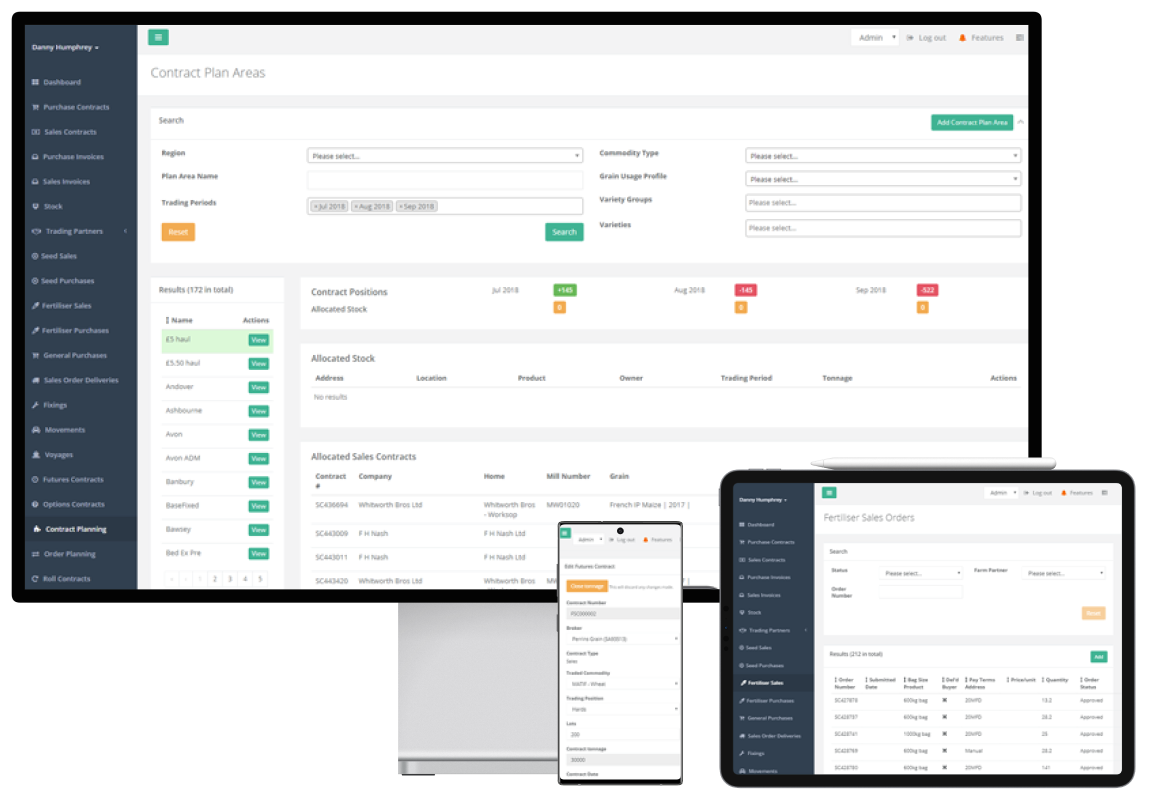
"Audacia created a solution that meets our immediate needs today and has the capability to scale in line with our future business plans. We continue to work collaboratively together to further optimise a number of business functions through automation"
SImon Lennon, Head of Technology ADM
Key Results
- Supporting over £1bn trading contracts per year
- Reducing truck cancellation processing by 97%
- Managing over 5 million tonnes of commodity each year
- Delivering a 12x faster invoicing speed
- 80% reduction in finance admin costs
- Doubling trading and distribution commodities
- Eliminated employee workarounds in new platform
About the Author
Philip Rashleigh
Technical Director
Philip Rashleigh is a Microsoft Certified Solutions Developer and has worked in the technology industry for 10 years.
Phil is currently Technical Director at software development company Audacia, previously holding technical roles at HSBC and Barclays.
Phil is responsible for Audacia's technical strategy and infrastructure; deciding the most appropriate tools and technologies to apply to mission-critical software projects.
Download
*download form?*
